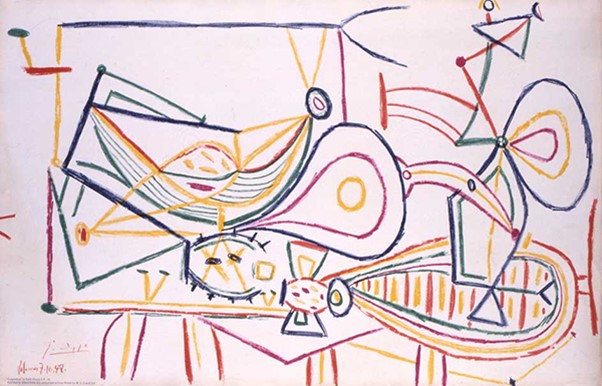Picasso
Composition, Vallauris 7- 10- 1948
1948
ARTIST:
Picasso, Pablo b. 1881, Malaga, Spain d. 1973, Moulins, France
Composition, Vallauris 7- 10- 1948,
signed, annotated and dated in the plate lower left, with publishing details in black print below lower left Lithograph in colours, 1948 Arches velin 86.0 cm x 49.7 cm Published by the Banyard Press, Printed by W.S. Cowell, Limited, Ipswich, England London, United Kingdom, 1949 Condition, very good with wear in edges of the paper, and a burn from the previous mount that is evenly at the outer edges of the paper: both consistent with the age of the piece.
Literature:
See Artmonsky, Ruth, School Prints: a Romantic Project, see also the review of the exhibition, The School Prints, https://corridor8.co.uk/article/school-prints/ see also https://artsandculture.google.com/asset/still-life-with-melon-pablo-picasso/-wFNGvORwNdwkw Private Collection, London, 2020, also https://www.christies.com/SaleLanding/index.aspx?intsaleid=24351&lid=3&saletitle= and https://www.telegraph.co.uk/news/obituaries/1560936/Brenda-Rawnsley.html See also https://www.pablo-ruiz-picasso.net/work-1408.php And https://www.pablo-ruiz-picasso.net/year-1948.php The year the work was executed, it was created with the title Still Life with Figs. Private Collection, United Kingdom 2020
Asking:
Contact for price
Commissioned by war widow Brenda Rawnsley as part of her School of Prints program, this work is an important symbol of one arts advocate’s dream to bring art to the masses and in particular, school children. Rawnsley believed that the very young should be exposed to high quality art at a young age, so embarked on a project that involved inviting artists to make an edition of a lithograph. These originals were sold to the public, while reproductions, made on ‘poster’ paper, were made and distributed to schools, to teach and expose the young, (as Rawnsley so desired), to the work of famous artists of the day. The contribution to the program by Pablo Picasso, takes on importance. Picasso, along with Braque and Matisse to name a few, were part of the European contingent to agreed to make a lithograph for the project. In this particular work, Picasso drew the design on transfers, which were then ‘copied’ or transferred onto a lithographic plate surface, then inked to the artist’s specifications. It was the first time that a lithograph had been produced in such a manner making Composition groundbreaking and important in the history of printmaking.
Picasso adhered to Rawnsley’s limit of six colours only rule for the lithograph, a specification that extended to all the artists who participated in the project. In this case, it is important to note that Picasso himself delivered the plates to Rawnsley, in order for the printing to take place, further diminishing the popular notion that the work was produced After Picasso. Composition, Vallauris 7-10-1948 is an excellent example of Picasso’s freer line work and his foray into spontaneous gesture, traits in his work that appeared in his post war oeuvre, and manifest in the rendering of the still life forms that were a departure from the rigidity of his analytical, angular and criss-crossing cubism from the 1920s and 1930s. In and around this time Picasso made the image, he popularised the melon as a motif, and during the late 40s this became his pictorial signature, featuring in many pastels, oils and lithographs. According to the Picasso estate records, Composition was based on a painting by the master from 1948 called Still Life with Melons, and elsewhere it is known as Still Life with Figs.[1] The work also closely resembles another work he executed on oil and now in a private collection in Europe. Elsewhere in the literature, Picasso’s subject matter pictorially describes Rawnsley’s journey to obtain the transfers directly from Picasso, contradicting the earlier narrative that Picasso delivered the art to Rawnsley. In another interpretation, the swirling line work of Composition was meant to symbolise the journey Rawnsley undertook to see the work realised for the Schools project.
In whichever way the onlooker chooses to interpret the clash of linear, jagged and curvilinear line work Picasso committed to the paper, the lithograph is considered significant, so much so that the prints produced by leading British and European artists, under the auspices of Rawnsley and her Schools Print Project, is now extant in the collection of the Tate in London. Picasso’s composition can also be found in the permanent collection of the Museum of Modern Art in New York.
Salon has housed the work in a custom built frame of lacquered black compo with a gold bulbous slip. The end result is spectacular.
[1] https://www.pablo-ruiz-picasso.net/year-1948.php
Email [email protected] to purchase.
